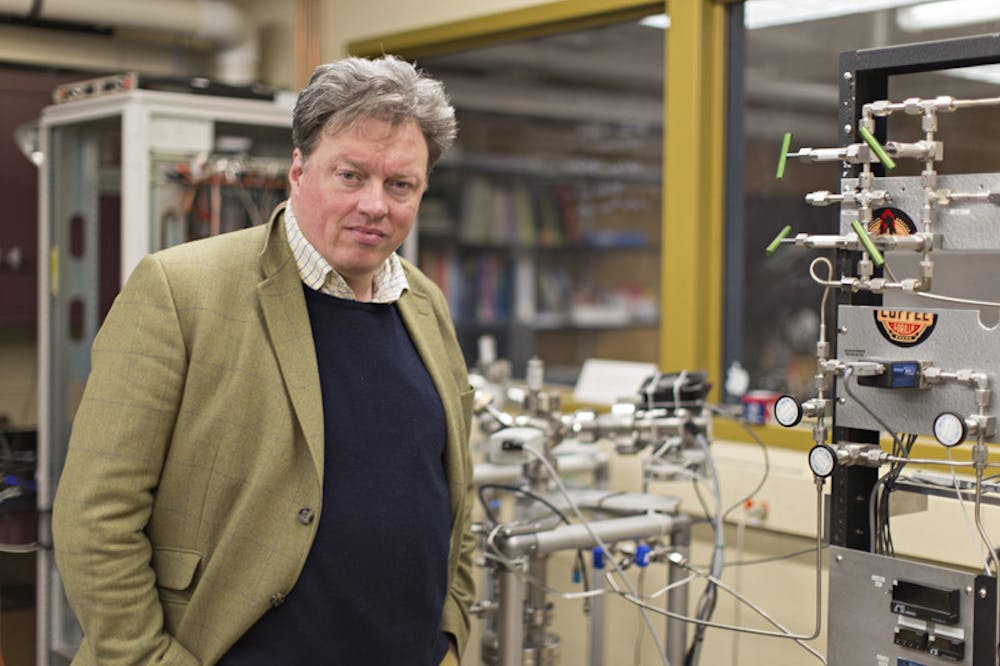A recent calibration of the Large Underground Xenon shows that researchers have come one step closer to detecting the elusive dark matter particle, according to results presented by a Brown graduate student Feb. 19 at the Lake Louise Winter Institute in Alberta, Canada.
Located a mile underground in South Dakota, the LUX is a large tub filled with a third of a ton of xenon liquid, said Richard Gaitskell, professor of physics. If a dark matter particle — a type of weakly interactive massive particle, or WIMP — interacts with a xenon nucleus, it will release a light and charge signal that will be picked up by sensors. The machine’s deep underground location minimizes radiation and other particles interfering with the intended dark matter interactions, he added.
Researchers completed the LUX’s first 90-day trial run in October, but the experiment’s initial results yielded no dark matter, The Herald reported in November.
The new calibration showed that if dark matter particles had passed through the LUX, they would have been detected, said James Verbus GS. He called this finding “the biggest thing since October.”
“When you say you are looking for WIMPs, you have to be able to demonstrate you would have seen them if they were there,” Verbus said. “The way you do this is by shooting neutrons into your detector, and (examining) the detector’s response.”
Neutrons are used because they and dark matter particles interact the same way with xenon atoms, Verbus said.
“James took the neutron source to the LUX a mile underground and was able to direct the neutrons coming from the source directly into the heart of LUX,” Gaitskell said.
The calibration works almost “like billiard ball scattering,” Gaitskell said. The neutrons are shot into the LUX and then bounce off multiple xenon atoms before being detected by the machine’s sensor, he added.
The researchers are able to measure the energy released by the interaction and calibrate the LUX accordingly, Gaitskell said. “The energies we were able to go down to were extremely low,” he added.
Calibrating the LUX to detect very low-energy particles is necessary to get around the difficulty of visualizing such low-energy particles as WIMPs, Verbus said.
The new calibration “further shows the robustness of LUX’s WIMP detecting capacity,” he added.
Recalibrating the machine allowed researchers to “determine that (their detector was) actually sensitive to lower-energy collisions than they had previously assumed,” wrote Associate Professor of Physics Ian Dell’antonio, who was not involved in the study, in an email to The Herald. “Because the lower-energy yield collisions are more common than higher-energy collisions, they showed that interaction rate had to be even lower than they had previously measured.”
“It’s about as big a gain as if they had run the experiment for three more years, so it’s a big deal,” he wrote.
For this experiment to be reliable, understanding the sensitivity of the detector is critical, Gaitskell said.
People have done many calibrations previously with an “entire spectrum of kinetic energy,” Verbus said. Unlike other calibrations, this one took place in the LUX itself, allowing multiple collisions to take place without leaving the detector, he added.
The size of the detector is crucial in discovering dark matter. If collisions took place in a smaller detector, the dark matter “would scatter once and then leave the detector,” Gaitskell said.
“We have only scratched the surface of what is possible,” Verbus said. The team is now working to prepare the LUX machine for the next attempt to find dark matter, which will be led by University researchers.
Though dark matter has yet to be found, “the LUX detector could still discover something in its next 300-day run,” Verbus said.
The researchers are also working on an even bigger detector called the LUX-Zeplin, Gaitskell said. This machine will be 20 times as big as the current LUX and will be more sensitive by a factor of 50.

ADVERTISEMENT




